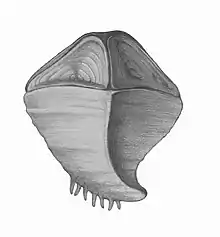Goniophyllum
Goniophyllum is an Silurian genus of rugose coral known from Sweden, Norway, Canada, the United Kingdom and the United States.[1] It is easily identified by its "lids" and distinct square shape. The genus was described by Milne-Edwards et Haime in 1851.[2]
.jpg.webp)
| Goniophyllum | |
|---|---|
 | |
| The species Goniophyllum pyramidale. | |
| Scientific classification | |
| Kingdom: | |
| Phylum: | |
| Class: | |
| Order: | |
| Family: | †Goniophyllidae |
| Genus: | †Goniophyllum Milne-Edwards et Haime, 1851 |
| Species | |
Description
The coralite is simple and square shaped. Growth segments are clearly visible. The calyx is deep with weak septa, but some are thicker and more distinguished than others. Four "lids" called opercula create a pyramid over the calyx that could be opened in life. These lids are triangular with distinct lingual and labial ornamentation. Muscle scars and a stolon tube is found on the inside of each operculum. One of the lids is slightly larger than the others and it’s the only one that is pressant in related genera such as Rhizophyllum. The corals internal Tabulae is very well developed much like other members of Cystiphyllida.[3]
Species and subspecies
- Goniophyllum fletcheri Milne-Edwards et Haime, 1851
- Goniophyllum osloense Johannessen, 2015
- Goniophyllum pyramidale primigena Lindström, 1882
- Goniophyllum pyramidale pyramidale Hisinger, 1831
References
- "Goniophyllum". Fossilworks. Retrieved 2019-06-20.
- "Goniophyllum". Fossiilid.net. Retrieved 2019-06-21.
- De Paleaeozoiska Formationernas Operkellbärande Koraller. G.Lindström. 1882-12-13